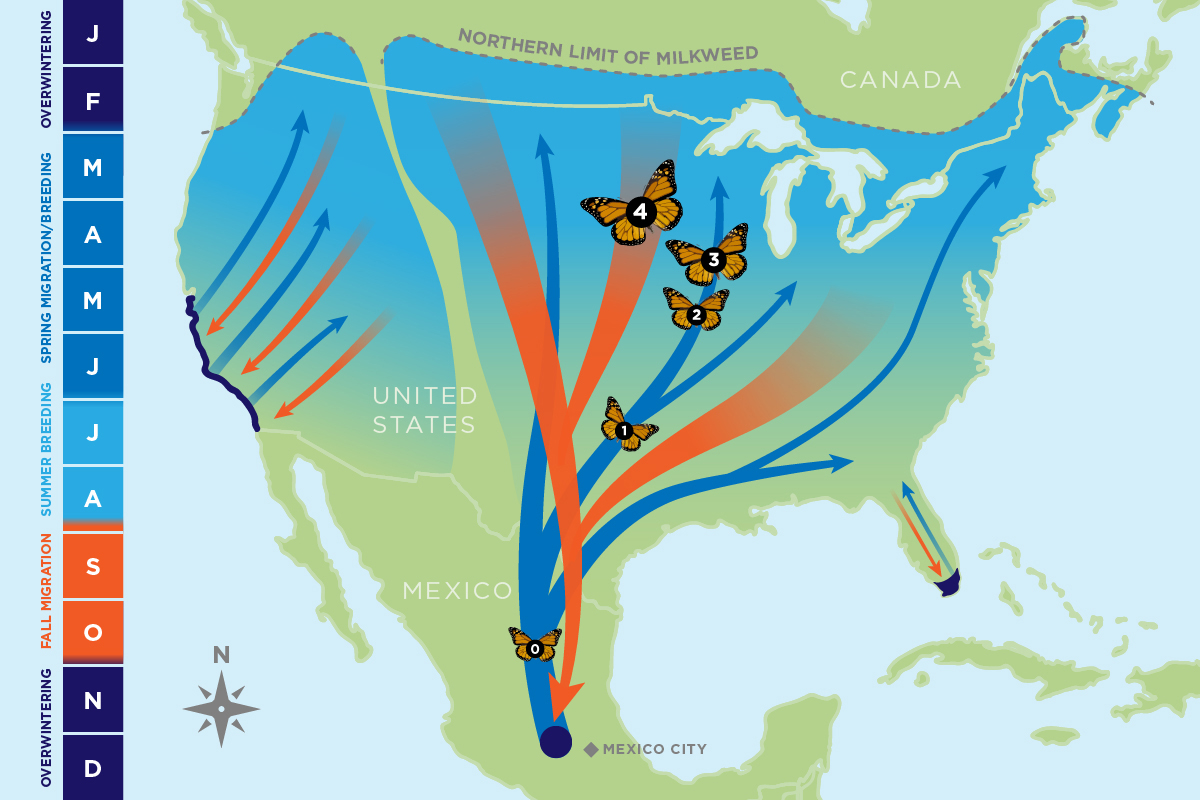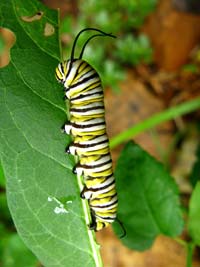Monarchs in North America
Monarch butterflies occur in North America, as well as other regions of the world. The most significant populations occur in North America and Mexico where they are generally divided into two populations, east and west of the Rocky Mountains. The western population is smaller, and those monarchs spend their winters along the California coast. The much larger eastern population winters in a single region – the forested mountains of central Mexico. Additionally, a very small non-migratory population winters in Florida.
Monarch Migrations
 Whether monarchs are present in a given area depends on the time of year. They are one of the few migratory insects, traveling great distances between summer breeding habitat and winter habitat where they spend several months inactive. In the summer they range as far north as southern Canada. In the fall the eastern population migrates to the cool, high mountains of central Mexico and the western population migrates to coastal California, where they spend the entire winter.
Whether monarchs are present in a given area depends on the time of year. They are one of the few migratory insects, traveling great distances between summer breeding habitat and winter habitat where they spend several months inactive. In the summer they range as far north as southern Canada. In the fall the eastern population migrates to the cool, high mountains of central Mexico and the western population migrates to coastal California, where they spend the entire winter.
In March, the first adults from the eastern population leave Mexico and begin their northern and multi-generational migration. Adult monarchs forage on a wide variety of flowering plants throughout their migration and breeding. They lay eggs only on milkweed plants in the genus Asclepias. The adults that wintered in Mexico primarily lay eggs on milkweed plants in northern Mexico, Texas, Oklahoma and Louisiana, but many travel to other southern states.
The population east of the Rocky Mountains contains the majority of the North American monarch population, which completes its northward migration through successive generations. They are found in the highest concentrations along a migratory flyway corridor through the central United States. In spring the monarchs leave overwintering grounds in Mexico and migrate north into Texas and the Southern Plains, then up through the Northern Plains and the Midwest, and finally up into the Great Lakes region. By late summer, eastern monarchs have spread north into Canada and eastward from the central migratory corridor throughout the Northeast and Southeast states.
From September into early October, fall southern migration to Mexico begins, with the majority of monarchs following the reverse path south along the central migratory corridor. Monarchs from the Northeast head south along the Atlantic coast, concentrating in the states that make up the Delmarva Peninsula between the Atlantic Ocean and the Chesapeake Bay on the journey. There are also non-migratory monarch populations in southern Florida and other parts of the America south along the Gulf Coast.
A much smaller population of monarch butterflies lives west of the Rocky Mountains. During summer, western monarchs live in canyons or riparian areas of the West, Southwest, inland California, and the inland Northwest states up to British Columbia. A small number of monarchs can be found in the coastal Pacific Northwest during summer months. Instead of making the long journey to Mexico, western monarchs only migrate as far south as coastal areas of central and southern California.
Life cycle
 Individual females lay about 400 eggs on milkweed plants and typically lay no more than two eggs on any single milkweed plant. The eggs hatch as larva in approximately 4 days, and larva feed exclusively on the leaves of milkweed plants. The poisons contained in the milkweed afford the larva some protection from vertebrate predators. Monarch larva mature for 9-14 days before seeking shelter to turn into a pupa. Upon pupation, which takes another 9-14 days, the new adult butterflies (the second generation) continue migration to the north and east. Depending on climatic conditions along the migration routes, the eastern monarchs may have as many as five generations during spring and summer. This multi-generational migration results in the eastern population spreading to all states east of the Rocky Mountains and into southern Canada. In the fall, individuals from the final summer generation migrate south to the wintering grounds in central Mexico, and the annual cycle is repeated the following spring.
Individual females lay about 400 eggs on milkweed plants and typically lay no more than two eggs on any single milkweed plant. The eggs hatch as larva in approximately 4 days, and larva feed exclusively on the leaves of milkweed plants. The poisons contained in the milkweed afford the larva some protection from vertebrate predators. Monarch larva mature for 9-14 days before seeking shelter to turn into a pupa. Upon pupation, which takes another 9-14 days, the new adult butterflies (the second generation) continue migration to the north and east. Depending on climatic conditions along the migration routes, the eastern monarchs may have as many as five generations during spring and summer. This multi-generational migration results in the eastern population spreading to all states east of the Rocky Mountains and into southern Canada. In the fall, individuals from the final summer generation migrate south to the wintering grounds in central Mexico, and the annual cycle is repeated the following spring.